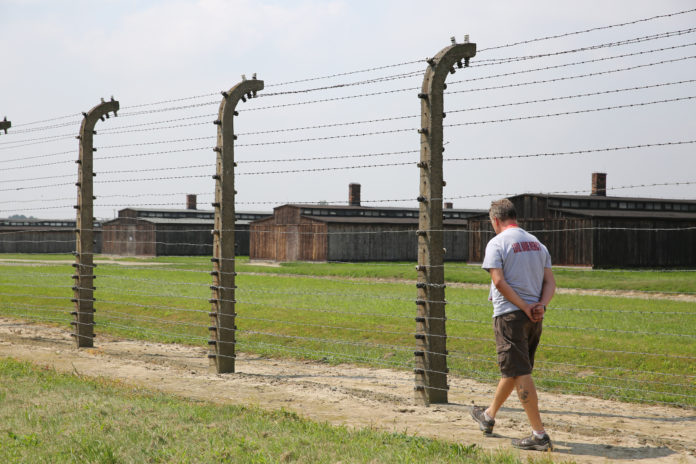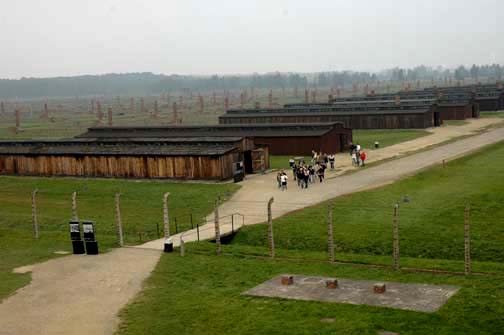Just behind the Mausoleum pictured in the photo below, and a little to the right, is a small stone which commemorates the deaths of around 18,000 Jews who died on that spot on November 3, 1943, an event that was code-named by the Nazis with the cynical word “Erntefest” which means Harvest Festival in English.
The camp inmates called this day “bloody Wednesday.” This was the largest mass execution carried out at any of the concentration camps in the history of the Holocaust. The victims were the last remnants of the Jewish population in the Lublin district.
Can you imagine 18,000 Jews being executed in just one hour? Why would the Nazis do something like this? These innocent Jews had never done anyone any harm — or had they?

The ashes of the 18,000 Jews, who were killed in one hour, are under this dome. Photo credit: Simon Robertson
The video below shows the trip taken by Holocaust survivor Cipora Hurwitz to the Majdanek camp where she was a prisoner.
The video above depicts the trip to Poland and the Majdanek death camp that Cipora Hurwitz helped to lead.
The trip became the basis of a new book authored by Cipora. The book is entitled Forbidden Strawberries.
http://www.multieducator.net/Books/Fo….
In the video, Cipora is shown as she takes a group of high school students from Israel and the US on a visit to the Majdanek death camp in Poland.
In his best-selling book Hitler’s Willing Executioners, Daniel Goldhagen wrote that the number of Jews executed at Majdanek that day was 16,500 and that there were an additional 14,000 Jews executed at Poniatowa.

Jews marching to their death on Bloody Wednesday
But why were these innocent Jews killed by those bad Nazis? Was there any justification for this? Does the term “illegal combatant” mean anything to you?
According to a book entitled The forgotten Holocaust: the Poles under German Occupation, written by Richard Lucas, these Polish resistance fighters were responsible for 6,930 damaged train engines, 732 derailed trains, 979 destroyed train cars, 38 bridges blown up, 68 aircraft destroyed, 15 factories burned down, 4,623 military vehicles destroyed, 25,125 acts of sabotage and 5,733 attacks on German troops.
In preparation for the mass execution at Majdanek, ditches were dug for the bodies behind the spot where the Mausoleum now stands, 50 meters away from the crematorium building. It took 300 prisoners, working two shifts day and night to dig three big ditches over 2 meters deep and 100 meters long, running in a zigzag line. These open ditches are still visible, although they look like they have been filled in somewhat.
Around 100 SS men were brought in from Auschwitz and other locations to do the shooting, according to the Majdanek guidebook. Very early on the morning of November 3, after roll call, all the Jews in Fields III and IV were ordered to form a column and march to the ditches.
The gravely ill Jews from the three typhus barracks in Field III were dragged out of their bunks and dumped onto trucks for transportation to the ditches. Loudspeakers mounted on trucks had been placed near the ditches, and by the camp gate near the street, to drown out the noise of the machine guns.
Simultaneously, a column of over 10,000 Jews were marched toward the gate of Field IV. The first prisoners reached the gate before the end of the column had left the city of Lublin. These victims were from the sub-camps of Majdanek and the work gangs employed outside the camp.
The Jewish political prisoners from the Gestapo prison in the Castle in Lublin were also marched to the camp. Around noon, the SS soldiers ordered the Jewish women out of their barracks in Field I, and again the sick were loaded onto trucks, while those able to walk were marched to the ditches.
The shooting started at around 6 or 7 o’clock in the morning, and lasted without a break until 5 p.m., with 100 victims at a time ordered to strip in a nearby barrack and then lie down in the ditches in groups of 10, where they were then machine-gunned to death.
Each new group had to lie down on top of the dead bodies from the previous group. The men were shot separately from the women.
The barbed wire fence was cut between Field V and the ditches, so that a column of armed policemen could form a passage, along which the victims were funneled into the ditches.
This operation was, by no means, done in secret. The shooting was done at the top of the low hill where the Mausoleum now stands and in full view of nearby residents who lived behind the area.
The loud dance music which went on for almost 12 hours that day ensured that the local residents knew that something unusual was going on, even if they couldn’t see it.
On the same day, there were other mass executions of Jews at the labor camps near the villages of Poniatowa and Trawniki.
According to a book entitled Poland, the Rough Guide, the liquidation of the Lublin Jews continued on November 4th and 5th. A total of 43,000 inhabitants of the Lublin ghetto were machine-gunned to death at Majdanek. The same book says that after the city was liberated by the Soviet Union, “Jewish partisan groups began using Lublin as their operational base.”
The bodies of the victims of the massacre at Majdanek were burned, near the ditches, on pyres formed from old truck chassis, and the ashes were thrown onto the compost pile behind the clothing warehouse barracks, which now hold the tourist exhibits. It is these ashes of the massacre victims which have now been given a place of honor in the Mausoleum.



















